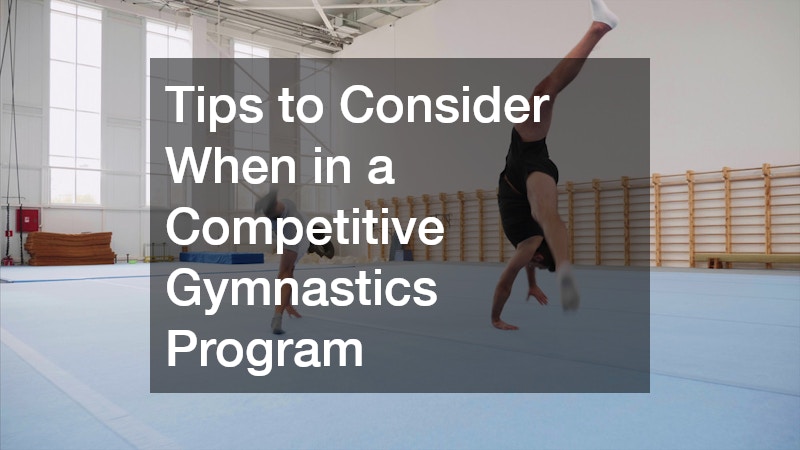
A competitive gymnastics program is an intense sport that demands physical strength, agility, and mental toughness. Gymnasts often face challenges such as balancing rigorous training schedules with academic commitments, preventing injuries, and maintaining a focused mindset under pressure. Preparation and mindset are crucial to overcoming these challenges, ensuring that athletes can excel in both their sport and their studies.
Video Source
Time management is essential for gymnasts who must juggle training and schoolwork effectively without compromising performance in either area. Utilizing planners or digital calendars can help athletes track assignments and deadlines, ensuring they remain organized and productive. The key is to establish a consistent daily routine that includes designated time for both homework and physical training, reducing the likelihood of last-minute stress. Techniques such as the Pomodoro Technique, which involves working in focused bursts with brief breaks, can increase productivity and prevent burnout. Prioritizing tasks according to their deadlines and importance also ensures academic responsibilities are managed efficiently. By segmenting time into manageable blocks, gymnasts can maintain a healthy balance that accommodates their dual commitments.
Setting priorities is a vital skill for gymnasts striving to achieve success both in the gym and the classroom. The ability to determine what tasks require immediate attention helps in making effective decisions about how each day is structured. Learning to say no to activities that do not align with athletic or academic goals is often necessary to preserve focus. Identifying core objectives for both schoolwork and gymnastics helps athletes allocate their efforts more effectively. By doing so, they can dedicate appropriate time and energy to studying for important exams or mastering challenging routines. As priorities shift over time, maintaining flexibility is crucial to ensure that athletes can adjust their plans when necessary without feeling overwhelmed.
Preventing injuries in gymnastics begins with adopting effective warm-up and cool-down routines as part of each training session. A dynamic warm-up that includes activities like jogging, jumping jacks, and dynamic stretches can enhance flexibility and prepare the body for intensive activity. Similarly, incorporating a thorough cool-down phase with static stretching aids in reducing muscle soreness and promotes recovery. Research shows that gymnasts who consistently apply proper warm-up techniques experience fewer injuries compared to those who do not prioritize them. Taking time to gently reintroduce the body to rest after training helps reduce tension in the muscles and aids in the prevention of muscle strains and sprains. Progressive training techniques that gradually ramp up intensity are also beneficial in reducing the risk of injury.
Building strength and conditioning is essential in gymnastics to not only enhance performance but also minimize the risk of injury. Exercises such as bodyweight squats, planks, and resistance band drills are particularly effective for increasing core stability and joint resilience. A balanced regimen that focuses on muscle groups used frequently in gymnastics should be prioritized. Engaging in cross-training activities like swimming or biking can offer a break from routine training while still promoting overall fitness. By diversifying training, gymnasts can develop different muscle groups and support their primary athletic movements more effectively. Strengthening complementary muscles helps prevent overload and overuse injuries common in gymnastics.
Mental toughness is a cornerstone of success in gymnastics, facilitating improved focus, resilience, and performance under pressure. Visualization techniques involve mentally rehearsing routines, imagining successful performance, and reinforcing positive outcomes. These techniques help gymnasts cope with anxiety and build confidence before competitions. Goal setting provides direction and motivation, enabling gymnasts to focus on incremental progress towards larger objectives. Structured, achievable goals keep athletes engaged, fostering a sense of accomplishment with each milestone reached. Regularly reviewing and adjusting goals ensures they remain relevant and challenging enough to promote growth.
Mindfulness techniques such as meditation, deep breathing, and progressive muscle relaxation are powerful tools to combat stress in gymnastics. Regular mindfulness practice enhances focus during routines and helps gymnasts detach from negative thoughts or distractions. Such techniques also improve self-awareness, promoting a calm, deliberate approach to competition. Awareness of stressors and developing coping mechanisms is crucial to maintaining composure in high-pressure situations. Emotional intelligence and self-regulation bolster mental resilience, elevating performance despite the challenges inherent in gymnastics. Working with mental health professionals or sports psychologists can provide additional support in building these skills.
In summary, success in a competitive gymnastics program requires a delicate balance of training, academics, and mental fortitude. Implementing time management strategies and setting clear priorities ensures gymnasts manage their commitments effectively. Prioritizing injury prevention and enhancing mental toughness are critical for sustaining long-term athletic success. Together, these elements support a holistic approach to excellence in a competitive gymnastics program.
